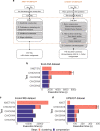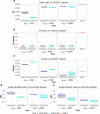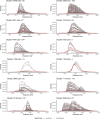CHICKN: extraction of peptide chromatographic elution profiles from large scale mass spectrometry data by means of Wasserstein compressive hierarchical cluster analysis
- PMID: 33579189
- PMCID: PMC7881590
- DOI: 10.1186/s12859-021-03969-0
CHICKN: extraction of peptide chromatographic elution profiles from large scale mass spectrometry data by means of Wasserstein compressive hierarchical cluster analysis
Abstract
Background: The clustering of data produced by liquid chromatography coupled to mass spectrometry analyses (LC-MS data) has recently gained interest to extract meaningful chemical or biological patterns. However, recent instrumental pipelines deliver data which size, dimensionality and expected number of clusters are too large to be processed by classical machine learning algorithms, so that most of the state-of-the-art relies on single pass linkage-based algorithms.
Results: We propose a clustering algorithm that solves the powerful but computationally demanding kernel k-means objective function in a scalable way. As a result, it can process LC-MS data in an acceptable time on a multicore machine. To do so, we combine three essential features: a compressive data representation, Nyström approximation and a hierarchical strategy. In addition, we propose new kernels based on optimal transport, which interprets as intuitive similarity measures between chromatographic elution profiles.
Conclusions: Our method, referred to as CHICKN, is evaluated on proteomics data produced in our lab, as well as on benchmark data coming from the literature. From a computational viewpoint, it is particularly efficient on raw LC-MS data. From a data analysis viewpoint, it provides clusters which differ from those resulting from state-of-the-art methods, while achieving similar performances. This highlights the complementarity of differently principle algorithms to extract the best from complex LC-MS data.
Keywords: Large-scale cluster analysis; Liquid chromatography; Mass spectrometry; Optimal transport; Proteomics; Wasserstein kernel.
Conflict of interest statement
The authors declare that they have no competing interests.
Figures






References
MeSH terms
Substances
Grants and funding
LinkOut - more resources
Full Text Sources
Other Literature Sources
Research Materials
Miscellaneous

